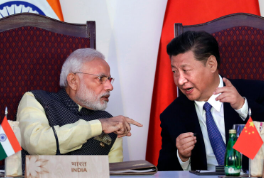India-China Sign Border Deal After Four-Year Negotiations
India and China signed a border deal after four years of negotiations. This agreement focuses on disengagement along the Line of Actual Control (LAC) in eastern Ladakh. The deal aims to enhance patrolling rights in the Depsang Plains and Demchok areas.
Background of Tensions
Tensions between India and China escalated in 2020 following the Galwan clash, which resulted in the deaths of 20 Indian soldiers and an undisclosed number of Chinese soldiers. The clash stemmed from disputes over the poorly defined 3,440 km border, leading to military confrontations. Since then insisted that relations with China would only improve once the border situation normalized.
Details of the Agreement
The agreement allows both nations to resume patrolling in previously established areas along the LAC. Indian Foreign Secretary Vikram Misri announced a breakthrough in patrolling arrangements, marking the end of the military standoff. The deal is the result of extensive diplomatic discussions, including 31 rounds of talks and 21 rounds of military discussions.
Changes Implemented by the Deal
- Resumption of Patrolling: Indian and Chinese soldiers can now patrol areas as they did before June 2020.
- Specific Areas of Focus: The deal particularly affects Depsang and Demchok, critical for military and water security.
- New Patrolling Protocols: Patrolling will occur twice a month, with a troop strength of 14-15 members per patrol.
- Coordination: Patrol programs will be shared, and dates will be adjusted if conflicts arise.
Implications of the Deal
The agreement is expected to de-escalate military presence in the region. Following the Galwan clash, both nations had increased troop deployments. The deal aims to reduce these tensions and promote stability along the border.
What Remains Unchanged
Despite the agreement, issues remain unresolved:
No Normalisation of Relations: Direct flights between India and China have been suspended for four years. India has not yet allowed their resumption.
Ban on Chinese Apps: India continues to restrict nearly 300 Chinese mobile applications due to concerns over data security.
Skepticism Among Experts: Analysts caution that while the agreement is a step towards normalcy, it does not signify a complete resolution of tensions.
Expert Opinions
Experts advise caution regarding the implications of the deal. Farwa Aamer noted that while the agreement is a step towards normalcy, the underlying issues between the two nations persist. Michael Kulegman emphasized that China remains a strategic competitor to India, and broader concerns will not diminish with this accord. Brahma Chellaney brought into light the need for vigilance, stating that China may not withdraw from its claims in disputed areas.
The India-China border deal marks an important development in diplomatic relations, but the path to lasting peace remains complex and fraught with challenges.
Month: Current Affairs - October, 2024
Category: International / World Current Affairs







